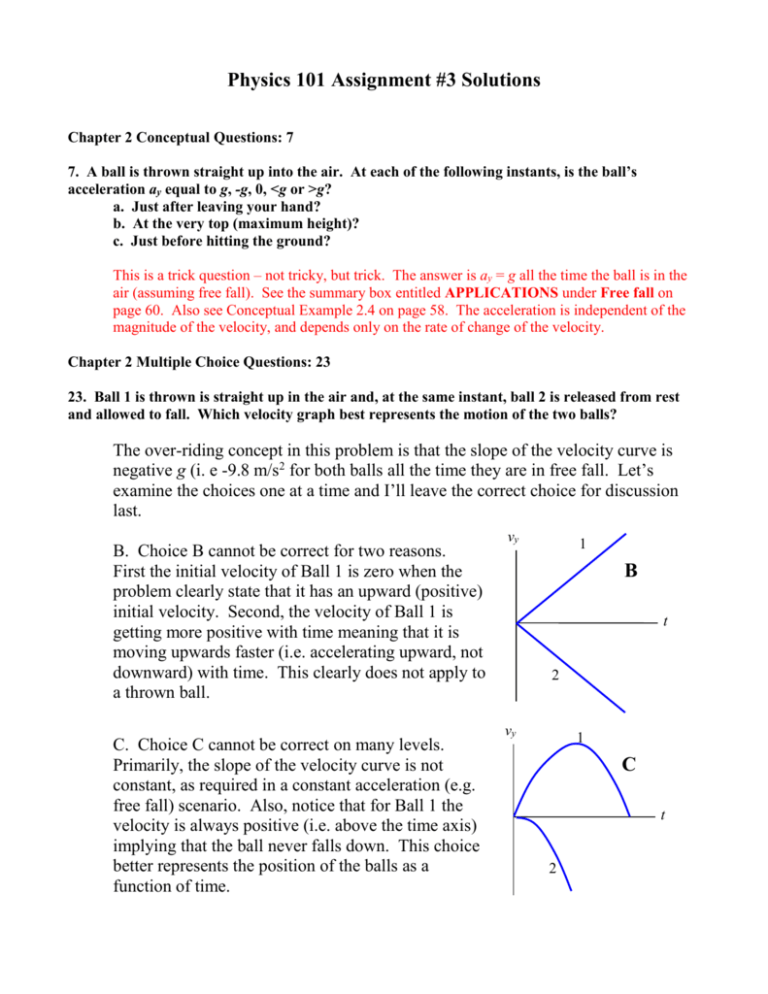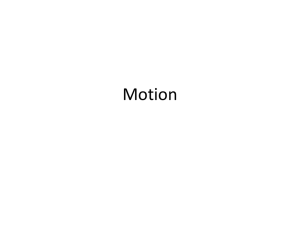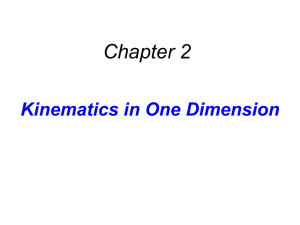Physics 101 Assignment #3
advertisement

Physics 101 Assignment #3 Solutions Chapter 2 Conceptual Questions: 7 7. A ball is thrown straight up into the air. At each of the following instants, is the ball’s acceleration ay equal to g, -g, 0, <g or >g? a. Just after leaving your hand? b. At the very top (maximum height)? c. Just before hitting the ground? This is a trick question – not tricky, but trick. The answer is ay = g all the time the ball is in the air (assuming free fall). See the summary box entitled APPLICATIONS under Free fall on page 60. Also see Conceptual Example 2.4 on page 58. The acceleration is independent of the magnitude of the velocity, and depends only on the rate of change of the velocity. Chapter 2 Multiple Choice Questions: 23 23. Ball 1 is thrown is straight up in the air and, at the same instant, ball 2 is released from rest and allowed to fall. Which velocity graph best represents the motion of the two balls? The over-riding concept in this problem is that the slope of the velocity curve is negative g (i. e -9.8 m/s2 for both balls all the time they are in free fall. Let’s examine the choices one at a time and I’ll leave the correct choice for discussion last. B. Choice B cannot be correct for two reasons. First the initial velocity of Ball 1 is zero when the problem clearly state that it has an upward (positive) initial velocity. Second, the velocity of Ball 1 is getting more positive with time meaning that it is moving upwards faster (i.e. accelerating upward, not downward) with time. This clearly does not apply to a thrown ball. C. Choice C cannot be correct on many levels. Primarily, the slope of the velocity curve is not constant, as required in a constant acceleration (e.g. free fall) scenario. Also, notice that for Ball 1 the velocity is always positive (i.e. above the time axis) implying that the ball never falls down. This choice better represents the position of the balls as a function of time. vy 1 B t 2 vy 1 C t 2 D. Choice D cannot be correct but is the closest to correct of the three choices examined so far. The velocity curve for Ball 2 is, in fact the correct. Ball 2 begins at rest and its velocity steadily increases in a downward direction with constant negative slope. However, Ball 1 is misrepresented in that the initial velocity should be positive, not negative. The problem state that Ball 1 was thrown upward, so the initial velocity should be above the time axis. vy D t 2 1 A. The only one left. Choice A is the correct vy velocity graph of the balls. Notice that the slope of A both velocity graphs is constant, negative and equal 1 to each other consistent with objects falling at a t constant acceleration. The initial velocity of Ball 1 is positive and Ball 2 is zero, as specified in the 2 problem. Let me point another interesting item from v studying these velocity curves. The difference in velocity between the two balls is constant (See the red dotted lines). What does this mean? Does it mean the balls always stay the same distance apart? No! It means that Ball 2 is always moving faster by the same amount downward that Ball 1.Since Ball 2 is always moving faster the distance between the two balls will increase the farther they fall.. Chapter 2 Problems: 30, 31, 54*, 60* vi = 0 30. Ball bearings can be made by letting spherical drops of molten metal fall inside a tall tower – called a shot tower and solidify as they fall. g = 9.9 m/s2 a. If a bearing needs 4.0 s to solidify enough for impact, how high must the tower be? Here we have a free fall problem where all our constant acceleration (all three of them) equations apply, with the caveat that a = g = 9.8 m/s2. Clearly, to find the 1 2 height of the tower x, use x vi t g t 2 . Since x= ? t= 4.0 s vf = ? the initial velocity is zero this simplifies to his simplifies to x 1 1 m 2 g t 2 9.8 2 4 s 78.4 m 2 2 s The tower must be 78.4 meters tall for the ball bearings to solidify before hitting the bottom. b. What is the bearing impact velocity? This second part can be answered two ways. First let’s just use the initial values of the problem. Since we know the time of fall and the acceleration we should use v f vi g t to solve for the final velocity. Since the initial velocity is zero we solve the simpler equation v f g t 9.8 m m 4 s 39.2 2 s s The final velocity of the ball bearings is 39.2 m/s. QED 31. In the chapter, we saw that a person’s reaction time is generally not quick enough to allow the person to catch a dollar bill dropped between the fingers. If a typical reaction time in this case is 0.25 s, how long would a bill need to be for a person to have a good chance at catching it. To answer this question you simply need to figure out how far an object falls in 0.25 seconds in free fall. Since free fall is a constant acceleration problem and you are given the initial velocity and time of flight, you should use the following equation to solve for the displacement. x vi t 1 g t 2 2 The initial velocity is zero so you just solve x 1 1 m 2 g t 2 9.8 2 0.25 s 0.306 m 30.6 cm 2 2 s The “bill” should be 30.6 cm long (about a foot long) for a person to have a chance of catching it. 54. Divers compete by diving into a 3.0 m deep pool from a platform 10- m above the water. What is the magnitude of the minimum acceleration that is needed to keep the diver from hitting the bottom of the pool? Assume the acceleration is constant. I like this question because you have to solve a simple problem before you can solve the assigned problem. That is, you will need to find the speed of the diver just as he/she hits the water first before you can determine the deceleration needed to stop the diver before hitting the bottom…a two part problem. Let’s look at the motion curves before we start the equations. The problem is constant acceleration (free fall a = g above the water and a = an unknown but constant value in the water). We know that the position versus time curves will be parabolic in shape and the velocity versus time curves will be linear with slope equal to the accelerations and, of course, the acceleration curve will be two horizontal lines one positive and one negative. x v a vMax B +9.8 m/s2 t t1 Both these areas should equal vMax t1 t t t1 This area should equal 10 m This area should equal 3 m -? m/s2 Just a few comments before we do the simple math part… 1. I have chosen downward to be the positive direction as seen in the acceleration graph where I have assigned g a positive value and the deceleration in the water to be negative. This choice is completely arbitrary and will not affect the final answer so long as I am consistent in my direction assignments. Also notice that I have assumed that the deceleration is going to be greater than g in creating the diagrams. I have assigned a time t1 to the time, after leaving the diving board, of impact into the water. We will not have to solve for this time to solve the problem, but it will give us an opportunity to check out answer. Now let’s get to solving the problem…. First find the velocity of the diver after freely falling 10 meters. Use the only constant acceleration formula that has no time, t, in it. v 2f vi2 2a x v 2f vi2 2 g x v 2f 2 g x v f 2 g x 2 9.8 m m 10 m 14 2 s s The diver hits the water at 14 m/s. Now he/she has to decelerate to come to rest after traveling 3.0 meters through the water. We apply the same formula v 2f vi2 2a x 0 vi2 2a x a vi2 2x 2 m 14 m s a 32.7 2 23m s The minimum acceleration needed to keep the diver from hitting the bottom of the pool is 32.7 m/s2. How would we check our answer, after all 32 m/s2 is a fairly high acceleration, equivalent to a bit over 3 g’s of acceleration? A simple check would be to see if the area under the two acceleration curves is equal. They should be equal in this problem because the change in velocity, in both parts of the problem, is equal. We need to find the time t1 to calculate the area under the acceleration curves. This time comes from solving x vi t 1 g t 2 for t. This yields 1.43 s for t1. Applying a similar 2 calculation for falling through the water (a = 32.7 m/s2) yields a time of 0.428 s to reach the bottom of the pool. As I mentioned earlier, the area under the acceleration curves will given the change in velocity. The areas under the two portions of the acceleration curve should be equal (but opposite in sign). If you calculate the areas, simple rectangles, you’ll see that they are in fact equal. 60. A lead ball is dropped into a lake from a diving board 5.0 m abouve the water. After entering the water it sinks to the bottom with a constant velocity equal to the velocity with which it hit the water. The ball reaches the bottom 3.0 s after it is released. How deep is the lake? Another two part problem. Clearly we need to determine the velocity of the ball as it hits the water and the time of fall to the water. First the velocity, then time. 1 a t 2 2 m 1 x f 0m 0 t a t 2 s 2 1 x f a t 2 2 2x f 2 5m t 1.01s m a 9.8 2 s x f xi vi t v v 2a x 2 f 2 i v 2f 0 2a x m 5m s2 m2 v 2f 98 2 s m v f 9.90 s v 2f 2 9.8 The ball hits the water at 9.90 m/s after 1.01 s of fall. Now we know that speed of the ball in the water (9.90 m/s) and the time it takes to get to the bottom of the lake (3.0s -1.01s=) 1.99s. So we use the definition of velocity v x t x v t 9.90 m 1.99s 19.7m s The lake has a depth of 19.7 meters. 64. Bob is driving the getaway car after the big bank robbery. He’s going 50 m/s when his headlights suddenly reveal a nail strip that the cops have placed across the road. If Bob can stop in time, he can throw the car into reverse and escape. But if he crosses the nail strip all his tires will go flat and he’ll be caught. Bob’s reaction time before he can hit the brakes is 0.60 s, and his car maximum deceleration is 10 m/s2. Is Bob in jail? No pontification with this problem. Let’s construct the motion diagram and then use the equations. Bob faces a two part problem (similar to several others we have seen). The first part is constant velocity for 0.6 s after he sees the nail strip but has not reacted to it. Second part is his deceleration (i.e. braking). The motion diagram will look like this… x v vi = 50 m/s Slope a = 10 m/s2 parabolic indicating constant acceleration Δt = 5s Linear indicating constant velocity t = 0.6 s t t m v s 5s t The time required to decelerate to a stop is given by v a t m a 10 s2 The area under the velocity curve equals the distance traveled. This is such a simple calculation that I have to do it. m 1 m 1 Area l w b h 50 0.6 s 5 s 50 155 m s s 2 2 Therefore, Bob doing time since the car would over-run the nail strip by 5 meters. If you had not done the motion diagram, you could have just made the following calculations m x v t 50 0.6 s 30 m s 1. Constant velocity portion: 50 2. Constant acceleration portion: Use v 2f vi2 2a x and solve for Δx. 2 m 50 2 v s So… x i 125 m m 2a 2 10 2 s The total displacement is the sum of the parts or 155 m. Adios, Bob.









